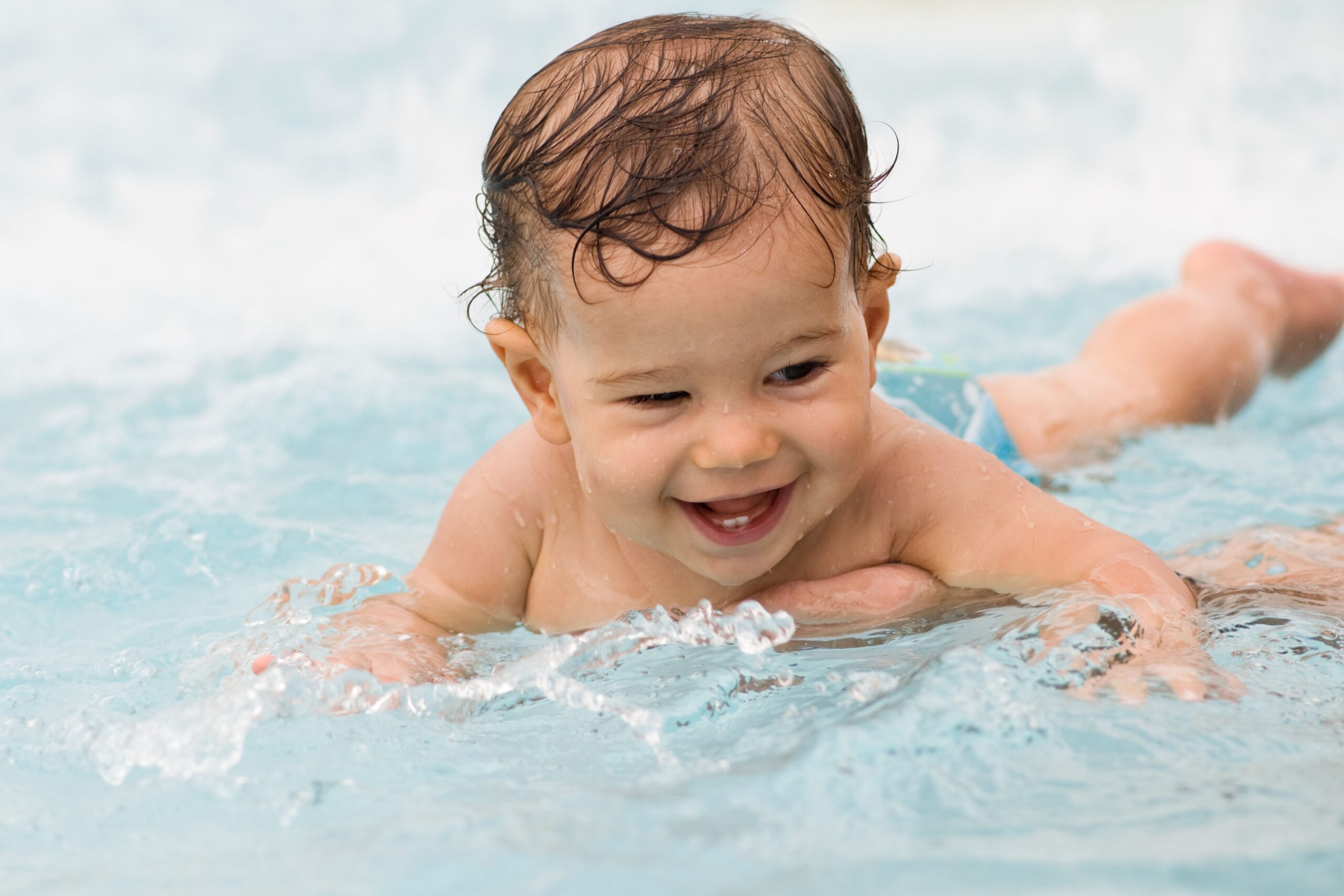As a new parent, you’re always looking for ways to support your baby’s development and create a strong bond with your little one. One enjoyable activity that offers numerous benefits for your baby’s growth is baby swimming. In this blog, we’ll discuss various strategies for introducing your baby to water and making the experience fun and safe. So, let’s dive in!
The Importance of Baby Swimming for Your Baby’s Development
Baby swimming is more than just a fun activity – it plays a crucial role in your baby’s development. Water play promotes motor skills, coordination, balance, sensory stimulation, cognitive growth, and social interaction. By introducing your baby to water early on, you’re setting them up for a lifelong love of swimming and a healthy lifestyle.
Strategies for Introducing Your Baby to Water
1. Start with a Gentle Introduction
The first step in introducing your baby to water is to create a positive experience. Begin by giving your baby a warm bath, allowing them to splash and play, and gradually increasing the amount of water in the tub. This helps familiarize them with the sensation of being in water and builds their confidence.
2. Create a Comfortable Environment
A comfortable and soothing environment is essential when introducing your baby to water. Ensure the room temperature is warm and the water is at a suitable temperature (around 100°F or 37-38°C). Soft lighting and calming music can also help your baby relax and feel secure.
3. Use Toys and Games
Incorporate age-appropriate toys and games into your baby’s water playtime to make the experience more enjoyable. Floating toys, water squirters, and colorful balls can keep your baby engaged and entertained while they become familiar with the water.
4. Encourage Exploration and Discovery
Allow your baby to explore the water at their own pace, providing gentle guidance and encouragement as needed. Help them discover new sensations by pouring water over their hands, letting them kick their feet, or guiding them to reach for toys.
Baby Swimming Tips for a Safe and Enjoyable Experience
1. Choose the Right Swimwear and Accessories
Invest in a good quality, comfortable swim diaper for your baby, as well as a snug-fitting swimsuit to keep them warm in the water. Don’t forget to pack a soft towel, a change of clothes, and a hat to keep them warm after swimming.
2. Apply Sun Protection
If you’re swimming outdoors, make sure to protect your baby’s delicate skin with sunscreen and a hat. Choose a sunscreen specifically designed for babies, with an SPF of 30 or higher, and apply it at least 15 minutes before heading outside.
3. Build Trust and Confidence
When introducing your baby to water, it’s crucial to build trust and confidence. Hold your baby securely and maintain eye contact while talking to them in a soothing voice. This will help them feel safe and reassured during their water experience.
4. Practice Water Safety Skills
As your baby becomes more comfortable in the water, start teaching them essential water safety skills, such as floating on their back, holding their breath, and kicking their legs. These skills will not only help them become better swimmers but also ensure their safety in the water.
5. Make it a Family Activity
Involving the whole family in baby swimming activities can be a great way to bond and create lasting memories. Older siblings can join in the fun and help teach their younger sibling about water safety and swimming skills.
6. Be Mindful of Your Baby’s Needs
Pay attention to your baby’s cues during water play and swimming sessions. If they appear tired, cold, or overwhelmed, it’s time to take a break. Remember that each baby is unique, and their comfort level with water may vary. Be patient and adjust your approach accordingly.
7. Celebrate Achievements
Acknowledge and celebrate your baby’s achievements in the water, no matter how small they may seem. This will help boost their confidence and motivate them to continue learning and enjoying their time in the water.
8. Stay Positive and Have Fun
Lastly, always maintain a positive attitude during your baby’s water play and swimming sessions. Your enthusiasm and enjoyment will be contagious, helping your baby develop a love for water and swimming that will last a lifetime.
By implementing these additional tips and strategies, you can further enhance your baby’s swimming experience and support their overall development. Happy splashing!
Making the Experience Fun and Relaxing
When introducing your baby to water, it’s essential to make the experience fun and relaxing. Sing songs, play with toys, and use gentle movements to help them feel at ease. Remember to always be patient and supportive, allowing your baby to progress at their own pace.
Consistency and Patience
Consistency is key when introducing your baby to water. Aim to incorporate water play and swimming into your baby’s routine at least once or twice a week. Be patient and allow your baby to progress at their own pace, providing support and encouragement along the way.
Give Your Baby Time to Get Used to Water
Babies need time to get used to being in water, so don’t expect them to love it straight away. Start by placing your baby on a towel or mat in shallow water, supporting them from underneath with one hand so they feel secure and safe. Remove any floatation aids first, then gently sink down into the water with your baby until it reaches about waist height.
Conclusion
Introducing your baby to water and baby swimming is a fantastic way to support their development and create lasting memories. By following these strategies, you can ensure a positive experience for both you and your baby, fostering a love for water and promoting their overall growth and well-being. So, grab those swim diapers and start splashing around with your little one today!
FAQs
1: At what age can I start introducing my baby to water and swimming?
You can start introducing your baby to water as early as a few weeks old by giving them warm baths and allowing them to splash and play. As for baby swimming, many experts recommend waiting until your baby is at least six months old. By this age, they have better head control and are less likely to swallow water accidentally. However, it’s essential to consult your pediatrician before starting any swimming activities.
2: Is baby swimming safe?
Baby swimming is generally considered safe when proper precautions and safety measures are in place. Always supervise your baby closely, ensure the water temperature is comfortable, and use flotation devices designed for babies. Enrolling in a baby swimming class can also teach you proper techniques and safety measures.
3: How can I help my baby overcome their fear of water?
If your baby is fearful of water, it’s essential to be patient and supportive. Start by introducing them to water gradually, using a gentle and fun approach. Create a comfortable environment, use toys and games, and encourage exploration and discovery at their own pace. Consistency and positive reinforcement can also help your baby overcome their fear and build confidence in the water.
4: How long should baby swimming sessions be?
For babies and young toddlers, it’s best to start with short swimming sessions of around 10-15 minutes.
Author
-


Dr. Sajid is a highly respected and experienced pediatrician who specializes in treating children of all ages. With a background in medicine and a passion for working with kids, Dr. Sajid has dedicated his career to helping young patients lead healthy and happy lives. He is particularly skilled in treating common childhood illnesses and developmental issues, such as allergies, asthma, and behavioral problems. Dr. Sajid is known for his gentle and compassionate approach to working with kids, and he is committed to making each visit to the doctor a positive and comfortable experience for his patients. His expertise in the field of pediatrics, combined with his warm and caring demeanor, make Dr. Sajid an excellent choice for families in need of a trustworthy and skilled kids doctor.
Drsajid@gmail.com Dr Sajid

